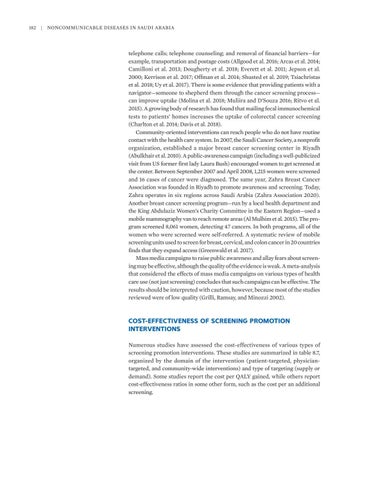182 | Noncommunicable Diseases in Saudi Arabia
telephone calls; telephone counseling; and removal of financial barriers—for example, transportation and postage costs (Allgood et al. 2016; Arcas et al. 2014; Camilloni et al. 2013; Dougherty et al. 2018; Everett et al. 2011; Jepson et al. 2000; Kerrison et al. 2017; Offman et al. 2014; Shusted et al. 2019; Tsiachristas et al. 2018; Uy et al. 2017). There is some evidence that providing patients with a navigator—someone to shepherd them through the cancer screening process— can improve uptake (Molina et al. 2018; Muliira and D’Souza 2016; Ritvo et al. 2015). A growing body of research has found that mailing fecal immunochemical tests to patients’ homes increases the uptake of colorectal cancer screening (Charlton et al. 2014; Davis et al. 2018). Community-oriented interventions can reach people who do not have routine contact with the health care system. In 2007, the Saudi Cancer Society, a nonprofit organization, established a major breast cancer screening center in Riyadh (Abulkhair et al. 2010). A public-awareness campaign (including a well-publicized visit from US former first lady Laura Bush) encouraged women to get screened at the center. Between September 2007 and April 2008, 1,215 women were screened and 16 cases of cancer were diagnosed. The same year, Zahra Breast Cancer Association was founded in Riyadh to promote awareness and screening. Today, Zahra operates in six regions across Saudi Arabia (Zahra Association 2020). Another breast cancer screening program—run by a local health department and the King Abdulaziz Women’s Charity Committee in the Eastern Region—used a mobile mammography van to reach remote areas (Al Mulhim et al. 2015). The program screened 8,061 women, detecting 47 cancers. In both programs, all of the women who were screened were self-referred. A systematic review of mobile screening units used to screen for breast, cervical, and colon cancer in 20 countries finds that they expand access (Greenwald et al. 2017). Mass media campaigns to raise public awareness and allay fears about screening may be effective, although the quality of the evidence is weak. A meta-analysis that considered the effects of mass media campaigns on various types of health care use (not just screening) concludes that such campaigns can be effective. The results should be interpreted with caution, however, because most of the studies reviewed were of low quality (Grilli, Ramsay, and Minozzi 2002).
COST-EFFECTIVENESS OF SCREENING PROMOTION INTERVENTIONS Numerous studies have assessed the cost-effectiveness of various types of screening promotion interventions. These studies are summarized in table 8.7, organized by the domain of the intervention (patient-targeted, physician- targeted, and community-wide interventions) and type of targeting (supply or demand). Some studies report the cost per QALY gained, while others report cost-effectiveness ratios in some other form, such as the cost per an additional screening.

